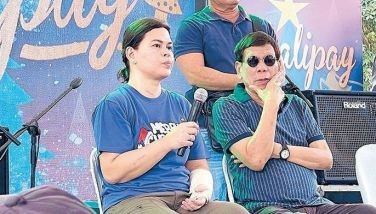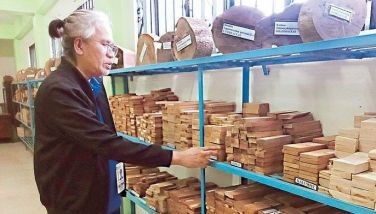GMA orders PNP to solve killings of judges, journalists
January 30, 2006 | 12:00am
President Arroyo has ordered the Philippine National Police (PNP) to institutionalize "Task Force Newsman" and to solve, as soon as possible, the killings of journalists and judges, a Palace official said yesterday.
Secretary Cerge Remonde, head of the Government Mass Media Group, said Mrs. Arroyo issued the directive to PNP chief Director General Arturo Lomibao in a recent meeting of the Cabinet cluster on national security at Malacañang.
He said Mrs. Arroyo also directed Lomibao to create another task force to investigate the killings of judges as well as to find ways to provide protection to members of the media and the judiciary. She also ordered the allocation of necessary funds and logistics "to make these task forces work."
"The President issued the order after Lomibao reported that 90 percent of all the cases involving the killings of journalists have been solved," Remonde said. "The President (asked) Lomibao what he meant by solved — whether the killers have been arrested and jailed."
Remonde said that "when Lomibao answered in the positive, the President pressed on to inquire whether the police have also caught the masterminds of these killings."
Lomibao, he said, replied that it is difficult to get the mastermind unless the arrested killers confess.
However, Mrs. Arroyo insisted that "the police should find a way."
Remonde said the President directed the PNP chief to coordinate closely with judges and media organizations to provide them security when necessary.
"The action of the President clearly showed her concern for the safety of journalists and judges. It definitely belies insinuations from certain quarters that the administration does not care about the killings of journalists and judges in the country," Remonde said.
He said it is easy to point an accusing finger at the government every time a journalist or a judge is murdered.
However, such criticisms of the government’s failure to stop the murders are valid, he added.
Nearly 100 journalists have been killed in the Philippines since 1986. At least 10 journalists were killed in the country last year.
The Philippines has repeatedly been tagged as the second most dangerous country in the world for journalists next to conflict-riddled Iraq.
Jose Torres, president of the National Union of Journalists of the Philippines (NUJP), said the Arroyo administration "has shown a penchant for blaming journalists for its political woes."
"Whether faced with corruption scandals or anti-insurgency efforts that go awry, it has tried to wriggle out of trouble by using the press as scapegoat. Its often hostile stance toward the Philippine media has exacerbated the dangers faced by journalists in this country," Torres said.
It will be recalled that, in November last year, the Philippines ranked a "poor" 139th among 167 countries on the World Press Freedom Index based on a survey conducted by the Paris-based Reporters Without Borders (RSF or Reporters Sans Frontieres).
The country’s poor press freedom ranking, at the lowest 20 percent of the index, indicates the growing occupational hazards faced by Filipino journalists, particularly in the provinces.
The RSF’s 2005 country report on the Philippines said that while Philippine authorities have achieved "significant progress" in their investigations of the murders of journalists, "impunity continues to undermine all efforts, encouraging killers and those who give them orders to commit further offenses."
The Manila-based Center for Media Freedom and Responsibility has said that only two of the 54 most recent killings of Filipino journalists were resolved by authorities in a manner that resulted in the criminal conviction of the culprits.
The 52 other cases are still being investigated either by the police or the prosecutor’s office, pending in court or dismissed for lack of evidence. — Paolo Romero
Secretary Cerge Remonde, head of the Government Mass Media Group, said Mrs. Arroyo issued the directive to PNP chief Director General Arturo Lomibao in a recent meeting of the Cabinet cluster on national security at Malacañang.
He said Mrs. Arroyo also directed Lomibao to create another task force to investigate the killings of judges as well as to find ways to provide protection to members of the media and the judiciary. She also ordered the allocation of necessary funds and logistics "to make these task forces work."
"The President issued the order after Lomibao reported that 90 percent of all the cases involving the killings of journalists have been solved," Remonde said. "The President (asked) Lomibao what he meant by solved — whether the killers have been arrested and jailed."
Remonde said that "when Lomibao answered in the positive, the President pressed on to inquire whether the police have also caught the masterminds of these killings."
Lomibao, he said, replied that it is difficult to get the mastermind unless the arrested killers confess.
However, Mrs. Arroyo insisted that "the police should find a way."
Remonde said the President directed the PNP chief to coordinate closely with judges and media organizations to provide them security when necessary.
"The action of the President clearly showed her concern for the safety of journalists and judges. It definitely belies insinuations from certain quarters that the administration does not care about the killings of journalists and judges in the country," Remonde said.
He said it is easy to point an accusing finger at the government every time a journalist or a judge is murdered.
However, such criticisms of the government’s failure to stop the murders are valid, he added.
Nearly 100 journalists have been killed in the Philippines since 1986. At least 10 journalists were killed in the country last year.
The Philippines has repeatedly been tagged as the second most dangerous country in the world for journalists next to conflict-riddled Iraq.
Jose Torres, president of the National Union of Journalists of the Philippines (NUJP), said the Arroyo administration "has shown a penchant for blaming journalists for its political woes."
"Whether faced with corruption scandals or anti-insurgency efforts that go awry, it has tried to wriggle out of trouble by using the press as scapegoat. Its often hostile stance toward the Philippine media has exacerbated the dangers faced by journalists in this country," Torres said.
It will be recalled that, in November last year, the Philippines ranked a "poor" 139th among 167 countries on the World Press Freedom Index based on a survey conducted by the Paris-based Reporters Without Borders (RSF or Reporters Sans Frontieres).
The country’s poor press freedom ranking, at the lowest 20 percent of the index, indicates the growing occupational hazards faced by Filipino journalists, particularly in the provinces.
The RSF’s 2005 country report on the Philippines said that while Philippine authorities have achieved "significant progress" in their investigations of the murders of journalists, "impunity continues to undermine all efforts, encouraging killers and those who give them orders to commit further offenses."
The Manila-based Center for Media Freedom and Responsibility has said that only two of the 54 most recent killings of Filipino journalists were resolved by authorities in a manner that resulted in the criminal conviction of the culprits.
The 52 other cases are still being investigated either by the police or the prosecutor’s office, pending in court or dismissed for lack of evidence. — Paolo Romero
BrandSpace Articles
<
>
- Latest
- Trending
Trending
Latest
Trending
Latest
Recommended






























